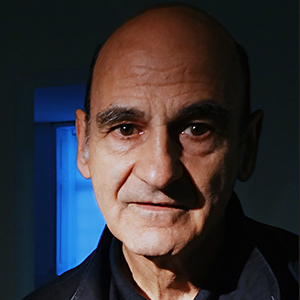Keynotes
Tuesday 8th December 2015
9:00 AM - 10:30 AM
SYMBIOTIC DESIGN
The last few years have witnessed a resurgence in the idea of the “smart” machine, much of it spurred on by recent advancements in AI, computer vision, robotics, machine learning and natural language processing. Computer systems that can act on our behalf, understand our intentions, and converse with us in human-like ways have once again taken hold of our collective imagination. But how realistic are these visions, and what does all of this mean for HCI? In this talk I will use some recent examples of designing and building “smart” technologies to argue that rather than aiming to build systems which replace human capabilities, we need to design systems that work in partnership with users. Further, building on Licklider’s notion of human-computer symbiosis, we need to engage in a process of “symbiotic design” whereby user behaviour is made intelligible to machines and machines are made intelligible to users.
BIO
Abigail Sellen is a Principal Researcher at Microsoft Research Cambridge where she manages the Human Experience & Design Group. Prior to Microsoft, she worked at Hewlett-Packard Labs, Rank Xerox EuroPARC, Apple Computer and Bell Northern Research. Abigail first became interested in Human-Computer Interaction through a summer internship at Apple while working on her doctorate in Cognitive Science with Don Norman. She has since published extensively on many diverse topics including the book The Myth of the Paperless Office (with co-author Richard Harper). Alongside honorary professorships at University College London and the University of Nottingham, she is a Fellow of the Royal Academy of Engineering, Fellow of the British Computer Society, and a member of the ACM SIGCHI Academy.
9:00 AM - 10:30 AM
SYMBIOTIC DESIGN
The last few years have witnessed a resurgence in the idea of the “smart” machine, much of it spurred on by recent advancements in AI, computer vision, robotics, machine learning and natural language processing. Computer systems that can act on our behalf, understand our intentions, and converse with us in human-like ways have once again taken hold of our collective imagination. But how realistic are these visions, and what does all of this mean for HCI? In this talk I will use some recent examples of designing and building “smart” technologies to argue that rather than aiming to build systems which replace human capabilities, we need to design systems that work in partnership with users. Further, building on Licklider’s notion of human-computer symbiosis, we need to engage in a process of “symbiotic design” whereby user behaviour is made intelligible to machines and machines are made intelligible to users.
BIO
Abigail Sellen is a Principal Researcher at Microsoft Research Cambridge where she manages the Human Experience & Design Group. Prior to Microsoft, she worked at Hewlett-Packard Labs, Rank Xerox EuroPARC, Apple Computer and Bell Northern Research. Abigail first became interested in Human-Computer Interaction through a summer internship at Apple while working on her doctorate in Cognitive Science with Don Norman. She has since published extensively on many diverse topics including the book The Myth of the Paperless Office (with co-author Richard Harper). Alongside honorary professorships at University College London and the University of Nottingham, she is a Fellow of the Royal Academy of Engineering, Fellow of the British Computer Society, and a member of the ACM SIGCHI Academy.
Wednesday 9th December 2015
9:00 AM - 10:30 AM
HUMAN COMPUTER INTERACTION & THE INTERNET OF THINGS:
OPPORTUNITIES AND CHALLENGES
Sitting at the intersection of the engineering sciences, the social sciences and the humanities, HCI is a nimble, innovation-focused discipline, responsive to the changing technological landscape: with technological innovation, new questions arise, new methods are developed and new insights into human nature emerge. The Internet of Things (IoT), we are told, is the emerging technological frontier, with networked physical objects or “things” that are embedded with electronics, software, and sensors pervading our everyday lives, all collecting and exchanging data. From smart cars to talking toasters, the opportunities for creating interactive ecosystems is exciting, but, equally, there are potential challenges for their management and maintenance. In this talk, I will speculate on the role of HCI as we move into the design of interactive ecosystems made up of ‘smart’ sentient devices, embedded computation and multiply layered services.
BIO
Elizabeth Churchill, a Director of User Experience at Google, is an applied social scientist working in the areas of human computer interaction, computer mediated communication, mobile/ubiquitous computing, and social media. Her current work focuses on the design of developer tools for device ecosystems.
Prior to her current position, her roles have included Director of Human Computer Interaction at eBay Research Labs in San Jose, California, Principal Research Scientist and Research Manager at Yahoo! in Santa Clara, California, and Senior Research Scientist at PARC (Palo Alto Research Center).
A psychologist by training, Churchill holds a BS in Experimental Psychology and an MS in Knowledge Based Systems from the University of Sussex, and a PhD in Cognitive Science from the University of Cambridge. She has more than 50 patents granted or pending, and over 100 publications in theoretical and applied psychology, cognitive science, human-computer interaction, mobile and ubiquitous computing, computer mediated communication and social media. She has co-edited the books Embodied Conversational Agents, Collaborative Virtual Environments, Inhabited Information Spaces, Public and Situated Displays, and Agent Supported Cooperative Work. Her co-authored text, Foundations for Designing User Centered Systems, was published in 2014, and her upcoming co-authored volume Designing with Data, will be published by O'Reilly in 2016. She has been a regular columnist for ACM's interactions magazine since 2008.
9:00 AM - 10:30 AM
HUMAN COMPUTER INTERACTION & THE INTERNET OF THINGS:
OPPORTUNITIES AND CHALLENGES
Sitting at the intersection of the engineering sciences, the social sciences and the humanities, HCI is a nimble, innovation-focused discipline, responsive to the changing technological landscape: with technological innovation, new questions arise, new methods are developed and new insights into human nature emerge. The Internet of Things (IoT), we are told, is the emerging technological frontier, with networked physical objects or “things” that are embedded with electronics, software, and sensors pervading our everyday lives, all collecting and exchanging data. From smart cars to talking toasters, the opportunities for creating interactive ecosystems is exciting, but, equally, there are potential challenges for their management and maintenance. In this talk, I will speculate on the role of HCI as we move into the design of interactive ecosystems made up of ‘smart’ sentient devices, embedded computation and multiply layered services.
BIO
Elizabeth Churchill, a Director of User Experience at Google, is an applied social scientist working in the areas of human computer interaction, computer mediated communication, mobile/ubiquitous computing, and social media. Her current work focuses on the design of developer tools for device ecosystems.
Prior to her current position, her roles have included Director of Human Computer Interaction at eBay Research Labs in San Jose, California, Principal Research Scientist and Research Manager at Yahoo! in Santa Clara, California, and Senior Research Scientist at PARC (Palo Alto Research Center).
A psychologist by training, Churchill holds a BS in Experimental Psychology and an MS in Knowledge Based Systems from the University of Sussex, and a PhD in Cognitive Science from the University of Cambridge. She has more than 50 patents granted or pending, and over 100 publications in theoretical and applied psychology, cognitive science, human-computer interaction, mobile and ubiquitous computing, computer mediated communication and social media. She has co-edited the books Embodied Conversational Agents, Collaborative Virtual Environments, Inhabited Information Spaces, Public and Situated Displays, and Agent Supported Cooperative Work. Her co-authored text, Foundations for Designing User Centered Systems, was published in 2014, and her upcoming co-authored volume Designing with Data, will be published by O'Reilly in 2016. She has been a regular columnist for ACM's interactions magazine since 2008.
Thursday 10th December 2015
9:00 AM - 10:30 AM
THE INHUMAN, THE POST-HUMAN & THE UNCANNY: ZOMBIES, CYBORGS AND CHIMERAS
Although we still nostalgically construct the human as a biological body, with this form and with these functions, possessing a mind of its own and with free agency, this is an outmoded imaginary of what it means to be human. We have always been zombies, have already become cyborgs and soon to have chimeric architectures. This is a time of Circulating Flesh, Fractal Flesh and Phantom Flesh where the body becomes an extended operational system, performing beyond the boundaries of its skin and beyond the local space that it inhabits. What it means to be being human is perhaps no longer remaining human, but rather becoming something other.
BIO
Stelarc is a performance artist who explores alternate anatomical architectures, using prosthetics, robotics and medical technologies. His projects include a Third Hand (an EMG actuated prosthesis with a tactile feedback system), Exoskeleton (6 legged locomotion actuated by arm gestures), Extended Arm (11 degree of freedom manipulator of primate proportions), and Prosthetic Head (an embodied conversational agent that speaks to the person who interrogates it). Fractal Flesh allows remote actuation of the body through a touch-screen interface and electrical muscle stimulation. Ping Body and Parasite explore the body choreographed by internet data streams. And Ear On Arm is a surgically constructed and stem-cell grown ear that will be electronically augmented and internet enabled.
In 2011 he initiated the Ambidextrous Arm project at Brunel University, London. Recent publications about the artist include Stelarc: The Monograph, Edited by Marquard Smith, Forward by William Gibson (MIT Press 2005). In 1996 he was made Honorary Professor of Art and Robotics at Carnegie Mellon University, Pittsburgh and in 2002 was awarded an Honorary Doctorate of Laws by Monash University, Melbourne. In 2010 he was awarded the prestigious Ars Electronica Hybrid Arts Prize. He is presently Distinguished Research Fellow and Director of the Alternate Anatomies Lab, School of Design and Art, Curtin University, Perth. His artwork is represented by Scott Livesey Galleries, Melbourne.
9:00 AM - 10:30 AM
THE INHUMAN, THE POST-HUMAN & THE UNCANNY: ZOMBIES, CYBORGS AND CHIMERAS
Although we still nostalgically construct the human as a biological body, with this form and with these functions, possessing a mind of its own and with free agency, this is an outmoded imaginary of what it means to be human. We have always been zombies, have already become cyborgs and soon to have chimeric architectures. This is a time of Circulating Flesh, Fractal Flesh and Phantom Flesh where the body becomes an extended operational system, performing beyond the boundaries of its skin and beyond the local space that it inhabits. What it means to be being human is perhaps no longer remaining human, but rather becoming something other.
BIO
Stelarc is a performance artist who explores alternate anatomical architectures, using prosthetics, robotics and medical technologies. His projects include a Third Hand (an EMG actuated prosthesis with a tactile feedback system), Exoskeleton (6 legged locomotion actuated by arm gestures), Extended Arm (11 degree of freedom manipulator of primate proportions), and Prosthetic Head (an embodied conversational agent that speaks to the person who interrogates it). Fractal Flesh allows remote actuation of the body through a touch-screen interface and electrical muscle stimulation. Ping Body and Parasite explore the body choreographed by internet data streams. And Ear On Arm is a surgically constructed and stem-cell grown ear that will be electronically augmented and internet enabled.
In 2011 he initiated the Ambidextrous Arm project at Brunel University, London. Recent publications about the artist include Stelarc: The Monograph, Edited by Marquard Smith, Forward by William Gibson (MIT Press 2005). In 1996 he was made Honorary Professor of Art and Robotics at Carnegie Mellon University, Pittsburgh and in 2002 was awarded an Honorary Doctorate of Laws by Monash University, Melbourne. In 2010 he was awarded the prestigious Ars Electronica Hybrid Arts Prize. He is presently Distinguished Research Fellow and Director of the Alternate Anatomies Lab, School of Design and Art, Curtin University, Perth. His artwork is represented by Scott Livesey Galleries, Melbourne.


